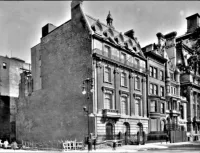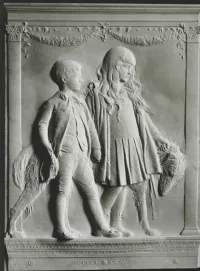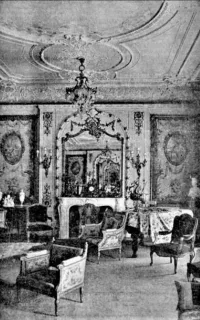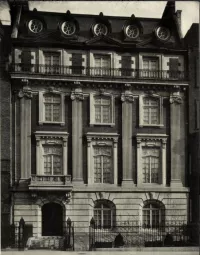Share what you know,
and discover more.
Share what you know,
and discover more.
Apr 13, 2023
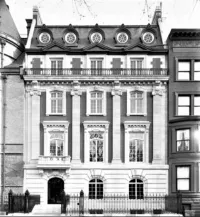
-

- Charmaine Bantugan
Jacob Schiff Mansion
Completed in 1901 and sold to Jacob H. Schiff (1847-1920) and his wife, Therese Loeb (1854-1933). Standing near the corner of Fifth Avenue and 78th Street with a 51-foot facade, it was designed by Freeman & Thain and built by the Farley brothers who on completion offered it for sale. Schiff paid $450,000 for the house, making it, "one of the most expensive dwelling houses ever built in the city by a builder on speculation". They then hired William Baumgarten & Co. to decorate the interiors with 'period' designs and furnishings. The only existing pieces of art the Schiffs brought with them were their portraits and a Saint-Gaudens bronze of their children - memorable to the children because they'd had to spend an entire Christmas holiday posing for it.... The mansion is often confused with 932 Fifth Avenue which Schiff bought as a wedding present for his son, Morti. His own mansion was initially numbered 968 Fifth Avenue before becoming 965 Fifth Avenue by about 1920. After the Schiffs were married in 1875, they lived at 57 East 53rd Street - a wedding present from Schiff's father-in-law, Solomon Loeb. Schiff disliked the proprietary manner with which various members of the extended Loeb family treated the house and he was delighted when he was able to move into a larger home on West 57th Street. However, that joy was short-lived when their neighbor added a new wing that immediately plunged the Schiff family home into the shadows. Schiff intended to build a new home at 73rd & Riverside, but his wife - who was miserable with the social restrictions placed upon her as a German-Jewish banker's "Frau" - convinced him to broaden their social horizons with a move to Fifth Avenue. Vacating West 57th Street before it was sold to Abraham Wolff, their son Mortimer, joked that it was now, "wonderful to be the master of a house in which I have been spanked so often"! "Impersonal and Stately Magnificence" Schiff's new house was critiqued by Architectural Digest in 1905, when they determined (perhaps with a hint of a sneer) that the, "prevailing character (is) that of an impersonal and stately magnificence (with) raised gold mouldings, Istrian marble, and wall coverings of crimson moiré silk". The walls in the entrance hall and up the marble stairs were panelled, "with veined statuary marble," all of which was illuminated by a stained glass dome above the hall. The 25-by-38 foot Dining Room was panelled in fine mahogany off from which stemmed the conservatory; and, the 15-by-44 foot hall to the Louis XV Drawing Room doubled as a ballroom with a minstrel's gallery at the opposite end. Other rooms of note included the 23-by-28 foot library and a billiards room in the basement, cleverly concealed from the servant's rooms on the same level. Not including the 15-bedrooms for the live-in staff on the top floor, each of the family and guest bedrooms (measuring between 20-by-23 feet and 18-by-19.6 feet) had their own bathroom and dressing room and were arranged around a large landing. Family Life at the "House Full of Horrors" Schiff may have been one of the sharpest minds on Wall Street, but his habit of not paying attention at auctions - coughing and gesturing without thinking - found him filling his already over-cluttered house with yet more objects he simply did not want, eg. a large pair of Chinese vases that ended up shoved awkwardly into the Dining Room. It became a long-standing joke in the family that every morning Schiff would ask his butler (Joseph) if he required an umbrella for the day. Every time Joseph felt an umbrella was necessary, Schiff would purposefully leave his behind: Schiff felt Joseph was invariably always wrong with his weather forecasts, just as Joseph felt Schiff was invariably always wrong with his financial speculations. According to Joseph, he made he plenty of money on the side precisely because he did not listen to Schiff's advice! Dinner was served on the dot of half past six o'clock, and anyone who arrived more than a second later went without their dinner. After dinner, Schiff tried to raise some enthusiasm for bowling - which he loved, but was a passion not shared by either of his children. Being only ever met by silence when he enquired who would like to join him for a game of bowls downstairs, Schiff would rise from the table and one unlucky shoulder would be tapped by his cane, indicating their selection as that evening's choice of bowling partner! Schifting with the Times Schiff died here in 1920 followed by his widow in 1933. That December, their children held an auction selling off over 100-paintings plus tapestries, silver, objets d'art etc. Among the paintings was those of the Old Masters such as Van Dyck, and Rubens' 17th century "Briseis Given Back to Achilles" now in the Detroit Institute of Fine Art. In addition there were 18th century portraits by George Romney; 17th Century portraits by Sir Peter Lely; landscapes by Corot; and, "Twilight in Florida" by the American George Inness. The mansion was placed on the market but in the throws of the Great Depression there were few interested parties and by 1937, having sat unsold and unoccupied for four years, Mortimer and Mrs Warburg took the decision to sell it - and the property that adjoined it at 967 - to developers. It was replaced in 1938 by the 18-story block that still stands today.
Jacob Schiff Mansion
Completed in 1901 and sold to Jacob H. Schiff (1847-1920) and his wife, Therese Loeb (1854-1933). Standing near the corner of Fifth Avenue and 78th Street with a 51-foot facade, it was designed by Freeman & Thain and built by the Farley brothers who on completion offered it for sale. Schiff paid $450,000 for the house, making it, "one of the most expensive dwelling houses ever built in the city by a builder on speculation". They then hired William Baumgarten & Co. to decorate the interiors with 'period' designs and furnishings. The only existing pieces of art the Schiffs brought with them were their portraits and a Saint-Gaudens bronze of their children - memorable to the children because they'd had to spend an entire Christmas holiday posing for it.... The mansion is often confused with 932 Fifth Avenue which Schiff bought as a wedding present for his son, Morti. His own mansion was initially numbered 968 Fifth Avenue before becoming 965 Fifth Avenue by about 1920. After the Schiffs were married in 1875, they lived at 57 East 53rd Street - a wedding present from Schiff's father-in-law, Solomon Loeb. Schiff disliked the proprietary manner with which various members of the extended Loeb family treated the house and he was delighted when he was able to move into a larger home on West 57th Street. However, that joy was short-lived when their neighbor added a new wing that immediately plunged the Schiff family home into the shadows. Schiff intended to build a new home at 73rd & Riverside, but his wife - who was miserable with the social restrictions placed upon her as a German-Jewish banker's "Frau" - convinced him to broaden their social horizons with a move to Fifth Avenue. Vacating West 57th Street before it was sold to Abraham Wolff, their son Mortimer, joked that it was now, "wonderful to be the master of a house in which I have been spanked so often"! "Impersonal and Stately Magnificence" Schiff's new house was critiqued by Architectural Digest in 1905, when they determined (perhaps with a hint of a sneer) that the, "prevailing character (is) that of an impersonal and stately magnificence (with) raised gold mouldings, Istrian marble, and wall coverings of crimson moiré silk". The walls in the entrance hall and up the marble stairs were panelled, "with veined statuary marble," all of which was illuminated by a stained glass dome above the hall. The 25-by-38 foot Dining Room was panelled in fine mahogany off from which stemmed the conservatory; and, the 15-by-44 foot hall to the Louis XV Drawing Room doubled as a ballroom with a minstrel's gallery at the opposite end. Other rooms of note included the 23-by-28 foot library and a billiards room in the basement, cleverly concealed from the servant's rooms on the same level. Not including the 15-bedrooms for the live-in staff on the top floor, each of the family and guest bedrooms (measuring between 20-by-23 feet and 18-by-19.6 feet) had their own bathroom and dressing room and were arranged around a large landing. Family Life at the "House Full of Horrors" Schiff may have been one of the sharpest minds on Wall Street, but his habit of not paying attention at auctions - coughing and gesturing without thinking - found him filling his already over-cluttered house with yet more objects he simply did not want, eg. a large pair of Chinese vases that ended up shoved awkwardly into the Dining Room. It became a long-standing joke in the family that every morning Schiff would ask his butler (Joseph) if he required an umbrella for the day. Every time Joseph felt an umbrella was necessary, Schiff would purposefully leave his behind: Schiff felt Joseph was invariably always wrong with his weather forecasts, just as Joseph felt Schiff was invariably always wrong with his financial speculations. According to Joseph, he made he plenty of money on the side precisely because he did not listen to Schiff's advice! Dinner was served on the dot of half past six o'clock, and anyone who arrived more than a second later went without their dinner. After dinner, Schiff tried to raise some enthusiasm for bowling - which he loved, but was a passion not shared by either of his children. Being only ever met by silence when he enquired who would like to join him for a game of bowls downstairs, Schiff would rise from the table and one unlucky shoulder would be tapped by his cane, indicating their selection as that evening's choice of bowling partner! Schifting with the Times Schiff died here in 1920 followed by his widow in 1933. That December, their children held an auction selling off over 100-paintings plus tapestries, silver, objets d'art etc. Among the paintings was those of the Old Masters such as Van Dyck, and Rubens' 17th century "Briseis Given Back to Achilles" now in the Detroit Institute of Fine Art. In addition there were 18th century portraits by George Romney; 17th Century portraits by Sir Peter Lely; landscapes by Corot; and, "Twilight in Florida" by the American George Inness. The mansion was placed on the market but in the throws of the Great Depression there were few interested parties and by 1937, having sat unsold and unoccupied for four years, Mortimer and Mrs Warburg took the decision to sell it - and the property that adjoined it at 967 - to developers. It was replaced in 1938 by the 18-story block that still stands today.
Apr 13, 2023
Jacob Schiff Mansion
Completed in 1901 and sold to Jacob H. Schiff (1847-1920) and his wife, Therese Loeb (1854-1933). Standing near the corner of Fifth Avenue and 78th Street with a 51-foot facade, it was designed by Freeman & Thain and built by the Farley brothers who on completion offered it for sale. Schiff paid $450,000 for the house, making it, "one of the most expensive dwelling houses ever built in the city by a builder on speculation". They then hired William Baumgarten & Co. to decorate the interiors with 'period' designs and furnishings. The only existing pieces of art the Schiffs brought with them were their portraits and a Saint-Gaudens bronze of their children - memorable to the children because they'd had to spend an entire Christmas holiday posing for it....The mansion is often confused with 932 Fifth Avenue which Schiff bought as a wedding present for his son, Morti. His own mansion was initially numbered 968 Fifth Avenue before becoming 965 Fifth Avenue by about 1920. After the Schiffs were married in 1875, they lived at 57 East 53rd Street - a wedding present from Schiff's father-in-law, Solomon Loeb. Schiff disliked the proprietary manner with which various members of the extended Loeb family treated the house and he was delighted when he was able to move into a larger home on West 57th Street. However, that joy was short-lived when their neighbor added a new wing that immediately plunged the Schiff family home into the shadows.
Schiff intended to build a new home at 73rd & Riverside, but his wife - who was miserable with the social restrictions placed upon her as a German-Jewish banker's "Frau" - convinced him to broaden their social horizons with a move to Fifth Avenue. Vacating West 57th Street before it was sold to Abraham Wolff, their son Mortimer, joked that it was now, "wonderful to be the master of a house in which I have been spanked so often"!
"Impersonal and Stately Magnificence"
Schiff's new house was critiqued by Architectural Digest in 1905, when they determined (perhaps with a hint of a sneer) that the, "prevailing character (is) that of an impersonal and stately magnificence (with) raised gold mouldings, Istrian marble, and wall coverings of crimson moiré silk". The walls in the entrance hall and up the marble stairs were panelled, "with veined statuary marble," all of which was illuminated by a stained glass dome above the hall. The 25-by-38 foot Dining Room was panelled in fine mahogany off from which stemmed the conservatory; and, the 15-by-44 foot hall to the Louis XV Drawing Room doubled as a ballroom with a minstrel's gallery at the opposite end.
Other rooms of note included the 23-by-28 foot library and a billiards room in the basement, cleverly concealed from the servant's rooms on the same level. Not including the 15-bedrooms for the live-in staff on the top floor, each of the family and guest bedrooms (measuring between 20-by-23 feet and 18-by-19.6 feet) had their own bathroom and dressing room and were arranged around a large landing.
Family Life at the "House Full of Horrors"
Schiff may have been one of the sharpest minds on Wall Street, but his habit of not paying attention at auctions - coughing and gesturing without thinking - found him filling his already over-cluttered house with yet more objects he simply did not want, eg. a large pair of Chinese vases that ended up shoved awkwardly into the Dining Room.
It became a long-standing joke in the family that every morning Schiff would ask his butler (Joseph) if he required an umbrella for the day. Every time Joseph felt an umbrella was necessary, Schiff would purposefully leave his behind: Schiff felt Joseph was invariably always wrong with his weather forecasts, just as Joseph felt Schiff was invariably always wrong with his financial speculations. According to Joseph, he made he plenty of money on the side precisely because he did not listen to Schiff's advice!
Dinner was served on the dot of half past six o'clock, and anyone who arrived more than a second later went without their dinner. After dinner, Schiff tried to raise some enthusiasm for bowling - which he loved, but was a passion not shared by either of his children. Being only ever met by silence when he enquired who would like to join him for a game of bowls downstairs, Schiff would rise from the table and one unlucky shoulder would be tapped by his cane, indicating their selection as that evening's choice of bowling partner!
Schifting with the Times
Schiff died here in 1920 followed by his widow in 1933. That December, their children held an auction selling off over 100-paintings plus tapestries, silver, objets d'art etc. Among the paintings was those of the Old Masters such as Van Dyck, and Rubens' 17th century "Briseis Given Back to Achilles" now in the Detroit Institute of Fine Art. In addition there were 18th century portraits by George Romney; 17th Century portraits by Sir Peter Lely; landscapes by Corot; and, "Twilight in Florida" by the American George Inness.
The mansion was placed on the market but in the throws of the Great Depression there were few interested parties and by 1937, having sat unsold and unoccupied for four years, Mortimer and Mrs Warburg took the decision to sell it - and the property that adjoined it at 967 - to developers. It was replaced in 1938 by the 18-story block that still stands today.
Posted Date
Apr 13, 2023
Historical Record Date
Apr 13, 2023
Source Name
House Histree
Source Website
Delete Story
Are you sure you want to delete this story?


